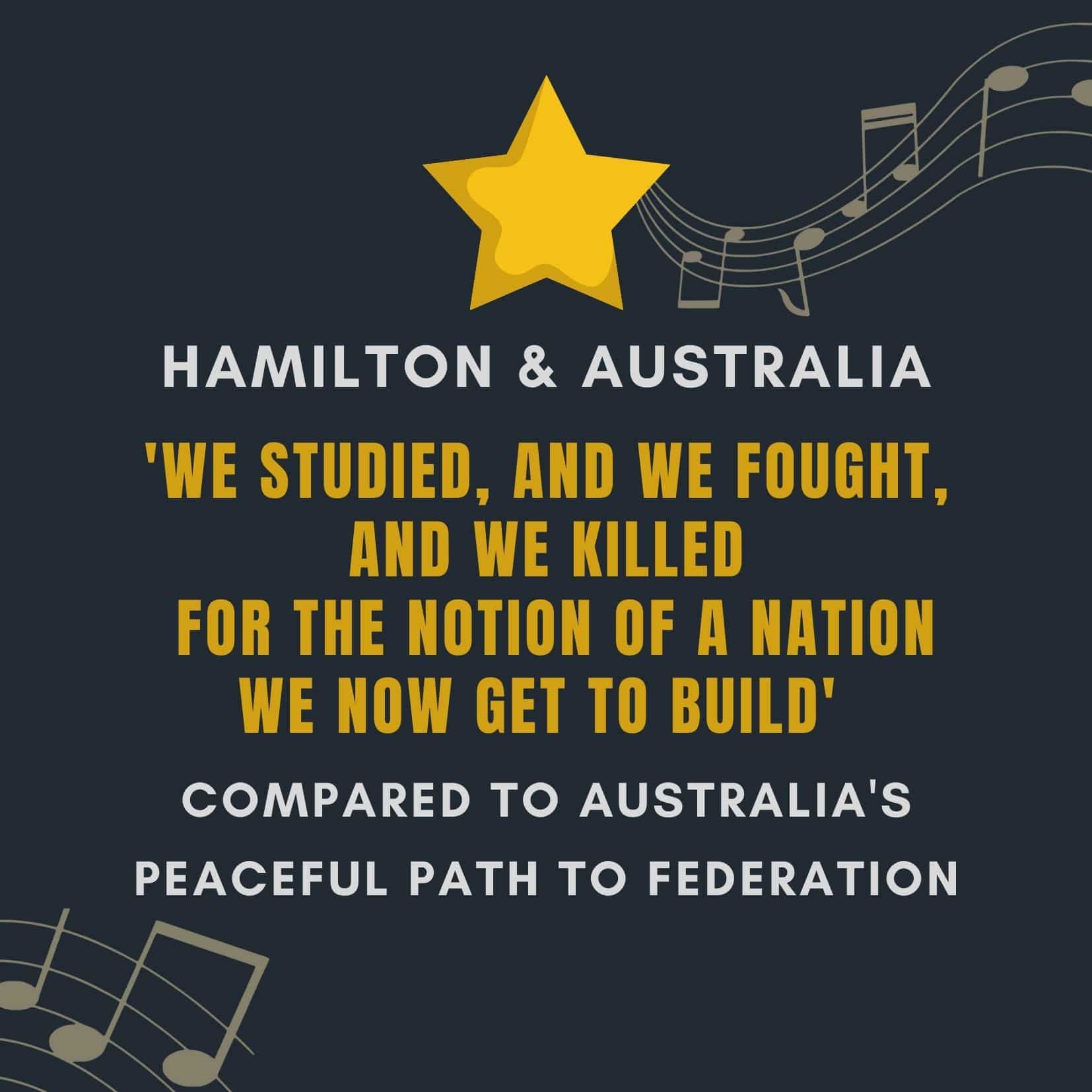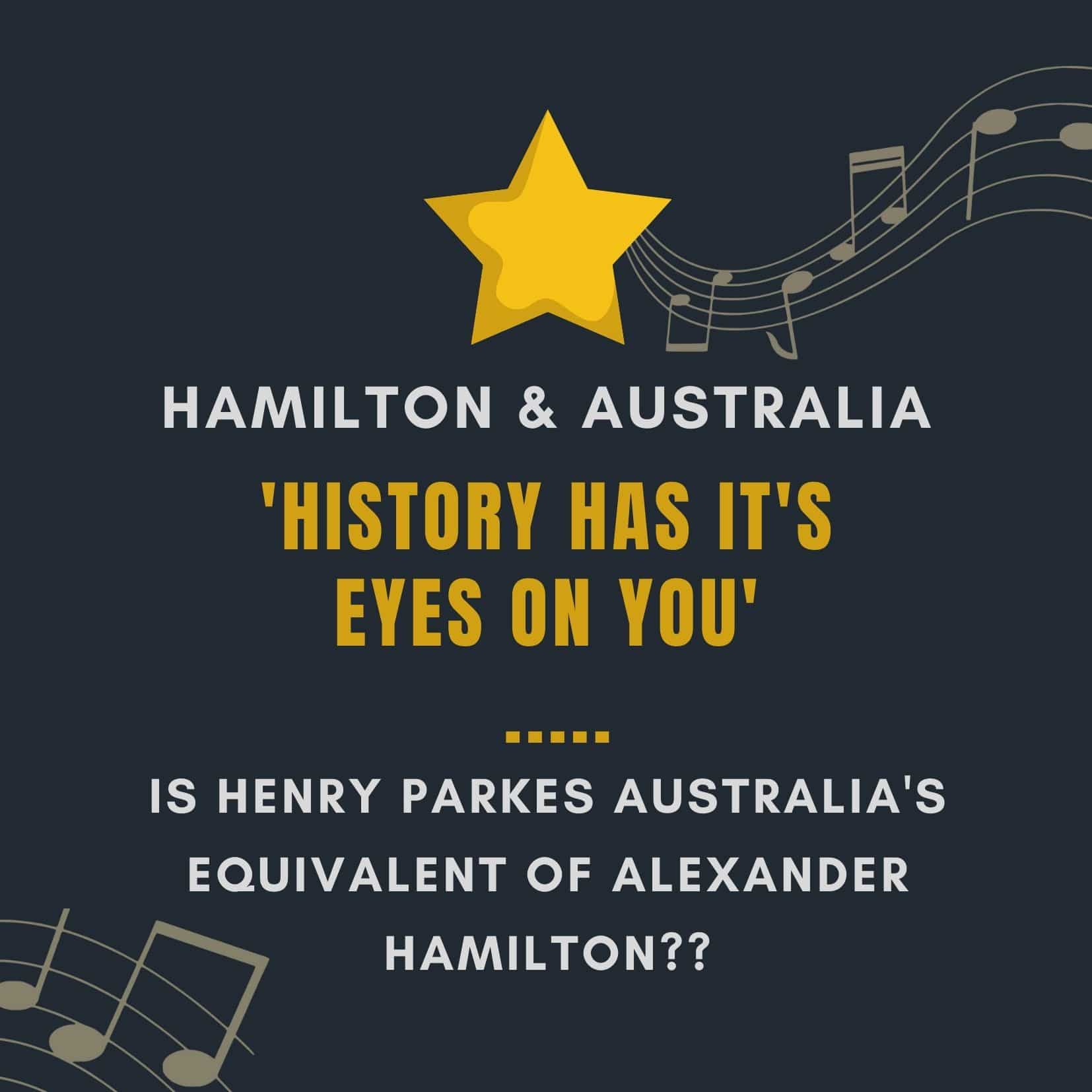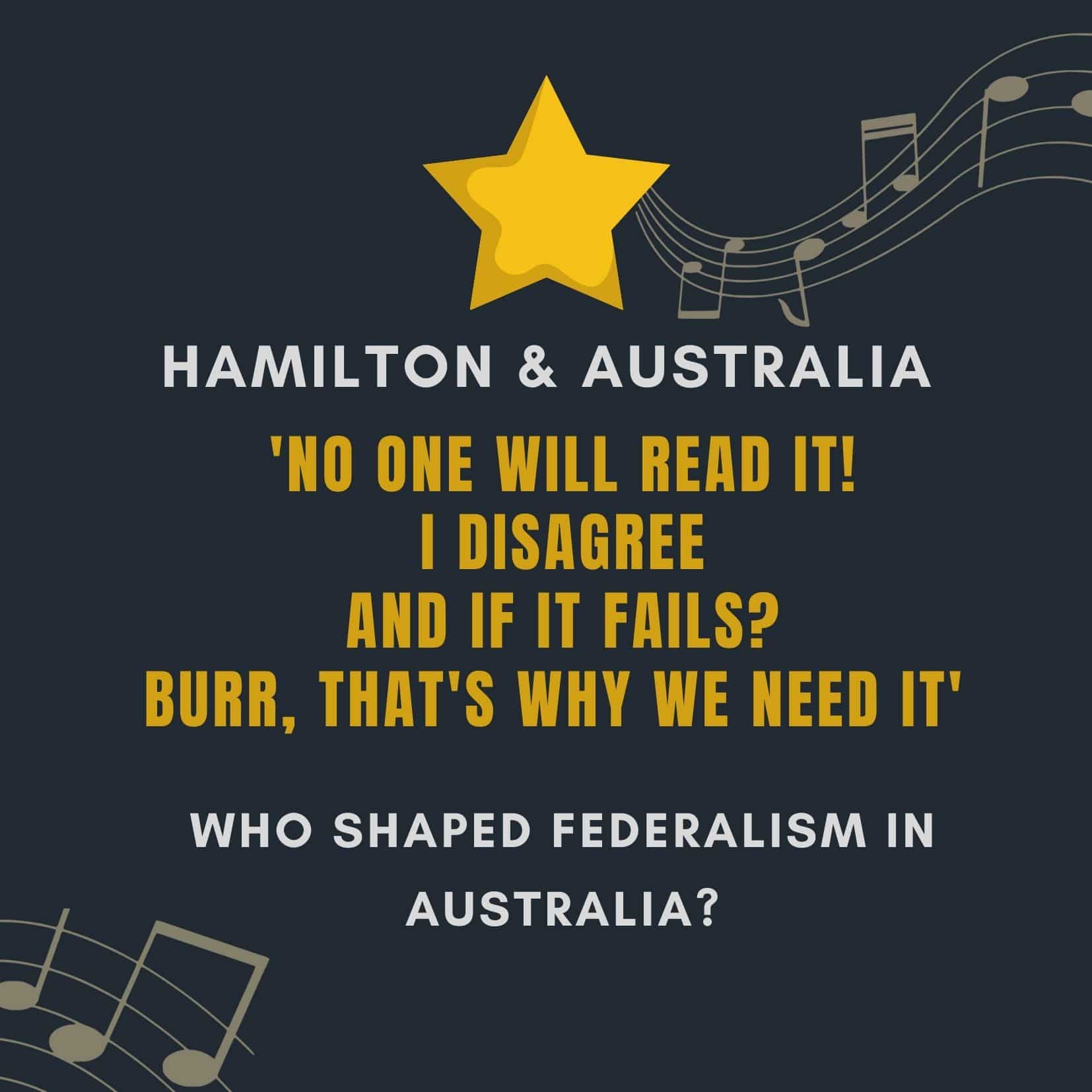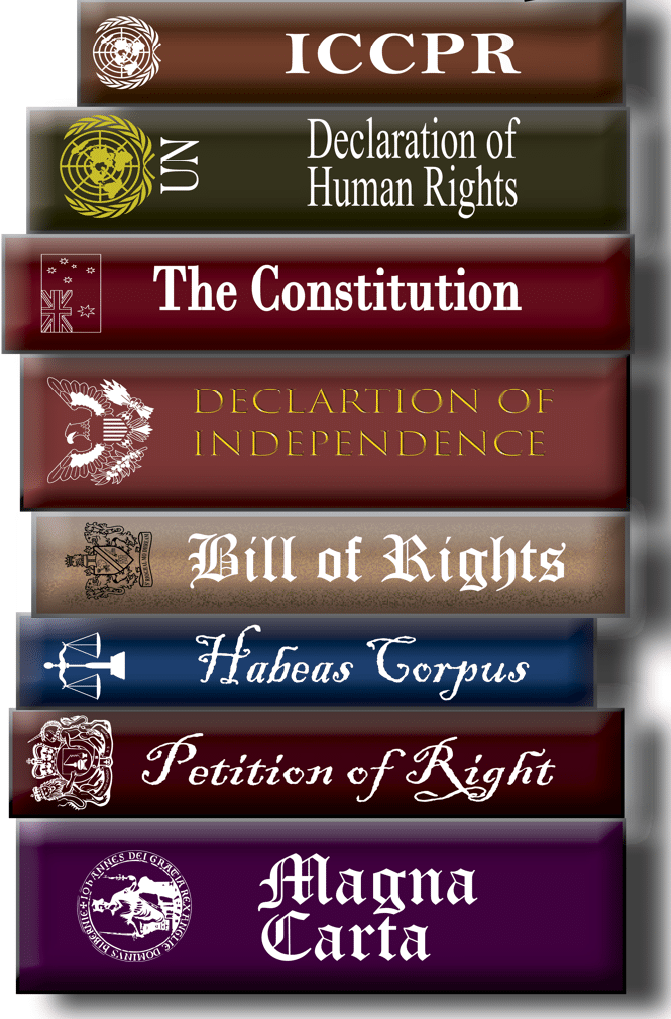Comparison of the Federation of Australia and the United States of America
The United States of America and Australia share many of the same foundations. In particular, both have systems of Government that derive from the British system of law and government with roots in the Magna Carta. These foundations are grounded in the rule of law that values individual rights and the protection from overbearing and arbitrary government action.
As a result of a different path to Federation and a different contextual setting, these nations have continued to have the same foundations but have them manifested in slightly different ways.
Many Australians know their American history based upon the musical ‘Hamilton.’ Using the songs from this musical as a prompt, this resources compares the different paths that Australia and America took on their journey to Federation.
Different Paths to Federation: War v Peace
The United States of America: Fight for Independence
The American colonies were first founded in the late 17th century by British settlers escaping religious persecution in England. The British Government also sent over 50,000 convicts to the American Colonies to alleviate their criminal problem.
In 1754, the French and Indian War raged throughout the frontier regions, caused by a larger imperial war between Great Britain and France. The British gained significant territory in North America during this time. The frontier colonies allied with Britain for protection and troops were stationed across the country. However, the costs of the war and protection of the colonies left the British government deeply in debt. New laws and taxes were imposed, including the Stamp Act (1765) and the Townshend Acts (1767). To further complicate matters, the burgeoning convict transportation program undertaken by the British Government at the time caused rapid population growth throughout the colonies.
Resentment towards Britain was growing. As the British government tightened its grip, the 13 American colonies resisted, with escalating tensions resulting in the Boston Massacre of 1770. The violent and deadly clashes reached a peak in around 1775 with the outbreak of civil war.
The American War of Independence raged over eight long years marked with much violence and bloodshed. The British surrender at Yorktown effectively ended the War, with a peace treaty being signed on Paris, France 3 September 1783. The American colonies had eventually won their independence from Britain, but it was not without cost.
The US Articles of Confederation established the functions of the national government of the United States after it declared independence from Great Britain. However, the Articles were too weak to hold the fast-growing nation together.
The idea of holding a convention to revise the Articles of Confederation grew in favour. US Nationals, led by Alexander Hamilton, James Madison, George Washington, John Jay and James Wilson worked tirelessly for a stronger federal system of government – one that united the people by guaranteeing civil rights and liberties, and access to fair representation. These people were key players at the Constitutional Convention that was held between 14 May and 17 September 1787 in Philadelphia, Pennsylvania, which led to the drafting of the US Constitution and the creation of the “United States” of America. Strong public sentiment in favour of states’ rights and a limited federal government later led to the creation of the Bill of Rights.

Hamilton, the American Musical Broadway smash hit, follows the revolutionary character Alexander Hamilton’s ascent from poverty to power, against a backdrop of the American War of Independence between 1775 to 1783.
‘We studied, and we fought, and we killed
For the notion of a nation we now get to build
For once in your life, take a stand with pride
I don’t understand how you stand to the side. . . ‘
– excerpt from ‘Non Stop’
Australia: Peaceful path to Federation
As a result of the American War of Independence, Britain could no longer send convicts to the US colonies. The British Government had to look for alternative destinations for its convict transportation program. Three years after the peace treaty with America was signed, the British Government decided to establish a new penal colony in New South Wales to send their unwanted felons. (Ignoring the fact that the Australian continent was already occupied by indigenous people.)
The British Home Secretary at the time, Lord Sydney (Thomas Townshend) and the first five early colonial governors, were instrumental in establishing a new penal colony, different to the US experience, formed according to the principles of English law that ensured all were subject to the law and equally accountable before it. By the late 19th century, Australia had grown to six independent self-governing British colonies, all managed under British control. Each colony had their own Constitution.
Under mounting pressure to be unified as one nation (particularly due to issues with cross border trading), delegates from the six Australian colonies came together for a series of constitutional conventions between 1898-1900, to draft the Constitution’s national legislative framework.
The primary aim of the Constitution was to unite the six colonies into one nation. The Constitution needed to create a government with enough power to act on a national level, but without so much power that fundamental rights and state representation would be put at risk. The committee agreed that to achieve this, separate government powers would be broken into three branches, providing checks and balances to prevent the abuse of those in power. Under the Constitution, the states could retain their own systems of government, with a separate federal government formed to manage laws affecting the entire nation. The result was a uniquely Australian Constitution with the ability to support enacting supreme law as the highest significant law; therefore, uniting the former British colonies.
Different to the American experience where they ‘fought’ and ‘killed’ ‘for the notion of a nation we now get to build’, Australia’s experience of federation occurred via peaceful referendums in each colony where citizens voted to come together as one nation.
Finally, the British Government had learnt from that painful and costly experience of the US War of Independence 100 years earlier, so on 9 July 1900, the British Parliament, without violence or bloodshed, passed legislation enabling six colonies to collectively govern as the Commonwealth of Australia. The Constitution commenced operation on 1 January 1901 – Australia had peacefully become a nation.

‘I know that we can win
I know that greatness lies in you
But remember from here on in
History has its eyes on you‘
– excerpt from ‘History has its eyes on you’
Founding Fathers: Hamilton v Parkes
The revolutionary character Alexander Hamilton is considered one of the Founding Fathers of the United States and a key figure in the drafting and ratification of the United States Constitution, that remains in effect today.
Notably, as with the American revolutionaries, Australia had its own Founding Father in Henry Parkes, someone who ‘history also had its eyes on’ and was ‘not throwin’ away my shot’. Parkes came to Australia as an ‘assisted immigrant’ who first worked as a labourer and later opened a shop that sold toys that he carved out of bone. A talented writer, orator, and colonial political activist, Parkes did not give up the notion of uniting Australia.
Interestingly,
“Henry Parkes was three times bankrupt, he kept a mistress and had children by her, and yet was five times premier of New South Wales.” (Hirst, Australia’s Democracy)
Like Alexander Hamilton, Parkes fought for fair representation, recognition of civil rights, and preserving individual freedoms. He continually worked with other influential contributors to achieve common ground, ‘writing like it’s going out of style’, re-writing points of contention to reach consensus on every aspect that impacted the colonies. Parkes led the process in drafting the Australian Constitution, adopting provisions from the constitutions of other countries, particularly those of the United States and the United Kingdom. Inspiration was drawn from the efforts of revolutionaries from other countries, such as Hamilton 100 years prior, and combined ideas with Constitution Acts of existing Australian colonies. In examining other models, the drafters hoped to avoid difficulties that had arisen in other jurisdictions. The best components of those models were selected and amalgamated into a tailor-made Australian Constitution.
Australia had its own Alexander Hamilton, in Henry Parkes. As immigrants to their adopted country, both men worked hard to achieve democratic milestones, and established a national doctrine by which millions of citizens live today. They are both unsung heroes and it is not surprising that both Parkes and Hamilton are commemorated on national currency.
Perhaps an award-winning musical will be written for us someday to celebrate and acknowledge the achievements of those dedicated Australians who set our path towards becoming a nation.

‘Who’s your client?
The new U.S. Constitution?
No
Hear me out
No way!
A series of essays, anonymously published
Defending the document to the public’
– excerpt from ‘Non Stop’
‘In the end, they wrote 85 essays
In the span of six months
John Jay got sick after writing five
James Madison wrote 29
Hamilton wrote the other 51′
– excerpt from ‘Non Stop’
Shared Vision of Federation: Protection against an overly powerful Federal Government
Only a true fan would want to unpack the lyrics from Non-Stop, the final song of Act I of Hamilton, and seek to understand what the lyrics are about.
The song references Alexander Hamilton when he was writing The Federalist Papers, a collection of 85 essays and articles written by Hamilton and fellow US founding fathers James Madison and John Jay. The Federalist Papers were originally published in New York on 28 May 1788. It tells the story of how Hamilton tried to convince American politician and lawyer Aaron Burr to co-author The Federalist Papers.
But before we go any further, let’s take a step back in American history. Prior to the start of The American War of Independence (1785-1783), delegates from the thirteen original states of the United States of America met and formed congressional bodies. They held meetings between 1774 and 1789 (before, during and after the War), in response to growing tensions between the colonies. The objective of these meetings, known as the First and Second Continental Congress, was to move the states towards declaring independence from the British Empire. Delegates sought to preserve the independence and sovereignty of the states and at the same time establish a central government. After much debate, The Articles of Confederation and Perpetual Union were drafted and approved and sent to the states for ratification. Approval by all 13 states was needed for the establishment of a constitution. The Articles finally came into force on 1 March 1781, naming the new nation “The United States of America”. In loose terms, the Articles of Confederation were the US’s first Constitution. In the years that followed, weaknesses in the Articles of Confederation began to appear, which led to the creation of the Constitution of the United States and the establishment of a stronger federal government.
Fast forward now to Non-Stop, the song references Hamilton’s involvement in The Federalist Papers which went towards trying to promote the ratification of the United States Constitution. The 85 essays and articles written by Hamilton, Madison and Jay were designed to address the problems of a weak central government and tried to influence voters at the Constitutional Convention in Philadelphia in 1787 to vote for a more powerful national government.
Interestingly, the authors published the collection of articles and essays under a pseudonym, “Publius”. It was quite common at the time for political writers to publish anonymously, especially if their ideas might be considered controversial. Hamilton was at pains to ensure his identity would be kept secret was because he knew he would be playing a significant role in the Constitutional Convention and was concerned that if his authorship was revealed, he might be accused of defending his own work, rather than seen to be making an objective case for the best possible federal constitution.
The outcome of the Constitutional Convention was the ratification of the US Constitution on 21 June 1788. Alexander Hamilton was a key player at that Convention, one of the most significant events in American history. The Federalist Papers shaped and heavily influenced the drafting of the US Constitution and Alexander Hamilton was one of the Federalists who led the charge, helping to create a document that endures as the oldest written constitution in the world.
More than that, Hamilton was instrumental in promoting the idea of federalism in the United States, a government in which power is divided between state and national levels.
Here in Australia, our very own Henry Parkes did something very similar. Parkes, often referred to as Australia’s “Father of Federation”, played a fundamental part in advocating for the federation of the six colonies of Australia. Throughout his life, Parkes worked towards his dream of Federation. His vision was fully realised after his passing, on 1 January 1901 when Australia became a Federation.
Federalism has ongoing significance today. One of the greatest advantages of a federal system is that it provides checks and balances on power, protecting the individual from an overly powerful government. It provides citizens with a wider range of choices. For example, Australians are able to vote for one party at the national level and another at the state level if they choose. Federal systems allow elected members of Parliament to accommodate diversity by bringing the government closer to the people through local representation and in doing so, provide a more flexible and responsible government. While local governance can continue to address local issues, the overarching federal framework can address national issues.
Both Hamilton and Parkes left us an invaluable legacy: their non-stop passion and vision for a federation.
If we were to start afresh as a nation, it is highly likely that Australians would still choose federalism as their preferred system of government. The geographic size of our nation alone lends itself to a federal system of government, one which can accommodate local level variations and needs but also address national issues. In addition, we see federations operating alive and well in other geographically large countries around the world such as Russia, Canada, Brazil, India, Argentina, Mexico, South Africa and Venezuela.
Federalism is therefore not an old-fashioned system anchored in the past. It is still alive and well and a significant part of our Australian identity and an important source of our prosperity.
FUN FACT: It was not until after his death that Hamilton was revealed as one of the authors of The Federalist Papers. Following Hamilton’s death in 1804, American historian Douglass Adair undertook an analysis of The Federalist Papers in 1944 and was able to identify the authorship of the various articles and essays. Hamilton is credited as having written 51 of them.
For further information, go to:
Creating the United States of America https://www.youtube.com/watch?v=uihNc_tdGbk
The Australian Constitution https://www.ruleoflaw.org.au/constitution/
A Series of Constitutional Conventions https://education.aec.gov.au/teacher-resources/federation/the-referendums.html
Australia’s Democracy: a short history (John Hirst 2002, Allen & Unwin)
An examination of Australia’s experiences in gaining independence from British control. Hirst describes a growing support for democracy amongst the six colonies from the time of European settlement.
The Foundation of A Nation https://www.ruleoflaw.org.au/constitution-day/

